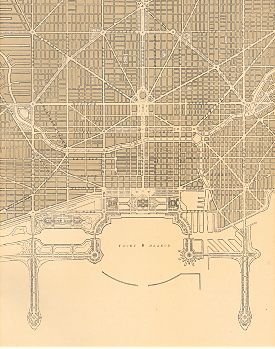1833, Chicago became a town and in 1837, Chicago had reached a population of 4170 and thus, became a city. In the 1840s, many Irish Catholics flocked to Chicago due to the Great Famine. Population boomed to about 300,000 as railroads developed. Heavy industry required skilled workers and many Europeans were attracted to Chicago such as Swedes, Germans, Dutch, and English.
In 1840, Chicago was the 92nd most populated city and, in just twenty short years, it became the 9th.
However, when the Great Chicago Fire of 1871 occurred, it destroyed many buildings and killed roughly 300 people. Rebuilding the city became a priority after that.
 |
| The Great Chicago Fire of 1871 |
Today's Chicago's foundations were based on the architects' designs for reconstructing the city after the Chicago Fire. Daniel Burnham was the one who created the first urban plan of the city.
 |
| 1909 Chicago Plan |
| Chicago's first skyscraper: the Home Insurance Building |
In 1885, the first skyscraper in the world, the Home Insurance Building, was built by William Jenney. It was this building that started the creative architectural structure of Chicago today.
In 1889, we see the Hull House open its doors to waves of immigrants by Jane Addams. These immigrants came to find work in meat packaging and other factories/industries. They were poor and needed a place to stay and found a home in these settlement houses.

In 1886, the Haymarket affair occurred where protesting workers were fired on by police. This caused unrest in protest and labor. Many African-Americans migrated to Chicago during the World War I era and found opportunities awaiting them there.
In the 1930s, Chicago had officially reached 3 million population wise. However, 1950 saw the very first time where population shrank due to jobs being scarce and being moved and people moving into suburbs.
The 2000 U.S. Census displayed the first increase in population since 1950.
Sources:
http://www.pbs.org/wgbh/amex/chicago/timeline/
http://www.aviewoncities.com/chicago/chicagohistory.htm
http://www.chicagoarchitecture.info/Building/3168/The-Home-Insurance-Building.php
http://www.history.com/topics/great-chicago-fire
http://www.uic.edu/depts/uichistory/hullhouse.html
In 1889, we see the Hull House open its doors to waves of immigrants by Jane Addams. These immigrants came to find work in meat packaging and other factories/industries. They were poor and needed a place to stay and found a home in these settlement houses.

In 1886, the Haymarket affair occurred where protesting workers were fired on by police. This caused unrest in protest and labor. Many African-Americans migrated to Chicago during the World War I era and found opportunities awaiting them there.
In the 1930s, Chicago had officially reached 3 million population wise. However, 1950 saw the very first time where population shrank due to jobs being scarce and being moved and people moving into suburbs.
The 2000 U.S. Census displayed the first increase in population since 1950.
Sources:
http://www.pbs.org/wgbh/amex/chicago/timeline/
http://www.aviewoncities.com/chicago/chicagohistory.htm
http://www.chicagoarchitecture.info/Building/3168/The-Home-Insurance-Building.php
http://www.history.com/topics/great-chicago-fire
http://www.uic.edu/depts/uichistory/hullhouse.html
No comments:
Post a Comment